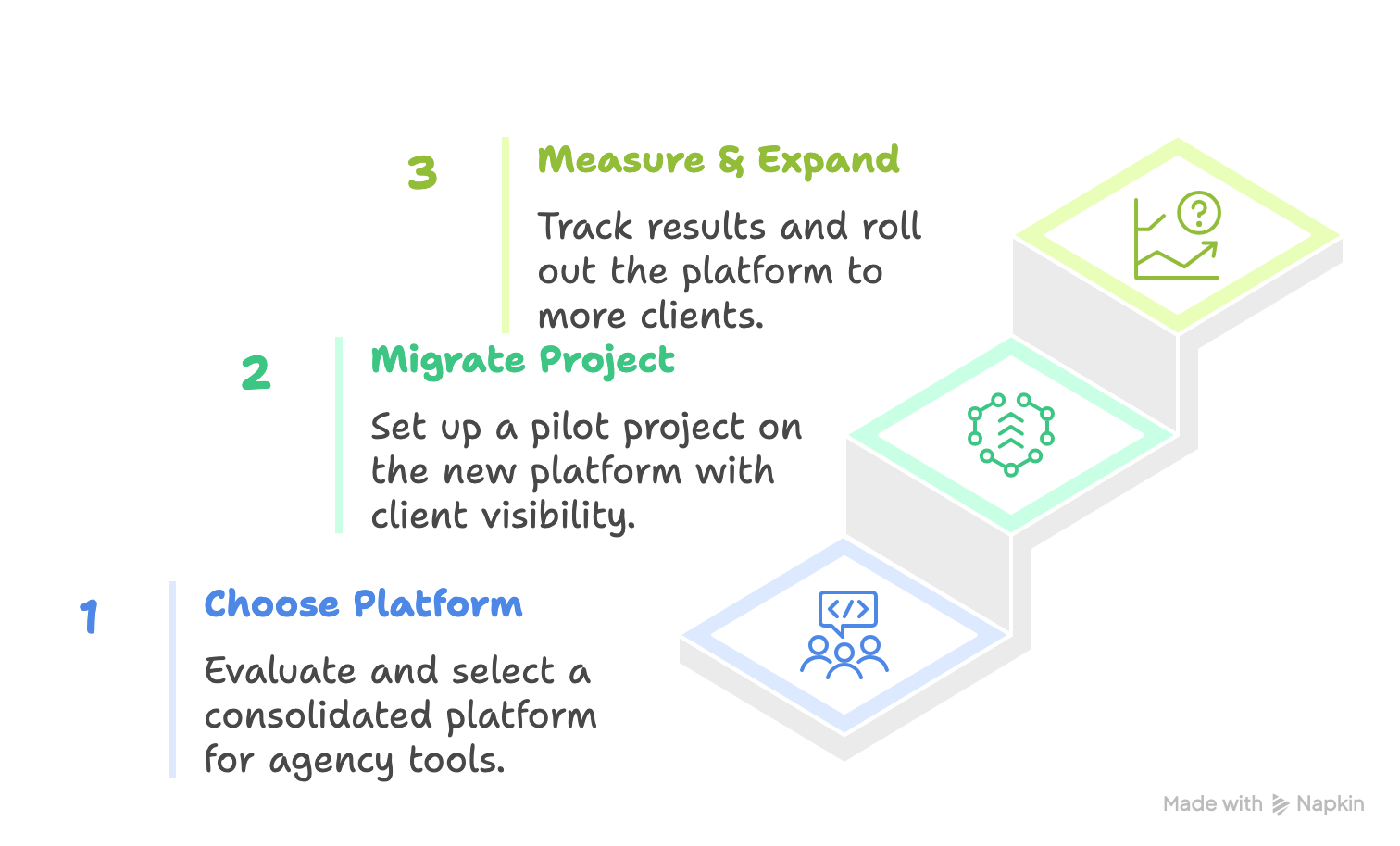Saving 15 hours weekly by giving clients what they actually want: visibility, not meetings
Your calendar just pinged again. Another client wants a status call. You check the clock. That's three meetings today about projects that are running fine.
Sounds like you relate to this, right?
Most agencies waste 40% of their workweek on client communication. That's two full days spent explaining what your team already completed.
I used to live in this chaos. My calendar looked like Tetris blocks of 30-minute status calls. Clients wanted updates. My team needed to prepare slide decks. Everyone felt busy, but nothing moved forward.
Then I discovered something counterintuitive. The more meetings you schedule, the less your clients trust you.
The Real Reason Clients Ask for Status Updates

Your clients don't actually want meetings. They want certainty. When they can't see project progress, anxiety fills the void.
68% of clients leave agencies because of poor communication, not poor work. Your deliverables might be perfect. Your designs might be stunning. But if clients feel left in the dark, they assume the worst.
Think about your last Amazon order. You didn't call customer service for updates. You checked the tracking page. That visibility created trust without human intervention.
Your agency needs the same system.
What 17 Cancelled Meetings Actually Means
I didn't ghost my clients. I replaced performative status calls with real transparency.
Here's what changed. Every client now has portal access. They see live project progress. Task completion happens in real time. File approvals move forward without email chains.
My team saves 15 hours weekly. That's 780 hours yearly we reinvested into actual client work. For a small agency, that equals roughly $50,000 in recovered productivity.
Clients stopped asking "what's the status" because they already know. Questions became strategic instead of tactical. Our calls shifted from reporting to problem-solving.
The Four Changes That Made This Possible
Change one: Centralized project visibility. I eliminated tool chaos. My team previously juggled Asana for tasks, Toggl for time, Google Drive for files, and QuickBooks for invoices. Each tool created information silos.
Now everything lives in one place. Clients log in and see complete project health instantly. No compilation required.
Change two: Real-time progress tracking. Status updates became automatic. When developers mark tasks complete, clients see progress immediately. No more waiting for Friday update emails.
This transparency eliminates 80% of status emails. Your inbox becomes manageable again.
Change three: Self-service client access. Clients can answer their own questions. They check project timelines without bothering your team. They review completed work at their convenience.
This shift transforms relationships. Anxious overseers become collaborative partners. Trust increases naturally.
Change four: Automated time tracking and billing. My team tracks hours within project workflows. Time data connects directly to tasks. Invoices generate automatically with accurate rates.
This integration recovered 38% of previously unbilled hours. Those forgotten consultation calls now generate revenue.
Why Most Agencies Stay Trapped in Meeting Hell
You know status meetings waste time. Research shows 75% of status meeting time serves no purpose. Yet agencies keep scheduling them.
Three psychological barriers keep you stuck. First, meetings feel productive. You're gathering information and making decisions. But you're really just collecting data that already exists somewhere.
Second, canceling meetings feels risky. What if clients think you are hiding something? The irony is that excessive meetings signal a lack of control. Transparent systems demonstrate confidence.
Third, tools seem complicated. Setting up centralized systems requires upfront work. But that investment pays dividends weekly. Every avoided meeting returns time to billable work.
The Three-Week Implementation Plan

You don't need to rebuild everything overnight. Start small and scale.
Week one: Choose your platform. Evaluate tools that combine project management, time tracking, and client portals.
Most agencies waste $300 to $500 monthly on fragmented tools. Consolidated platforms Like Teamcamp start at $99 monthly with unlimited users and you also getting start with $6/Per user plan.
Look for native integrations. Your team shouldn't toggle between six different apps. Everything should connect seamlessly.
Week two: Migrate one pilot project. Pick your most communication-heavy client. Set up their Client portal with full visibility. Include task progress, file sharing, and timeline tracking.
Train your client on self-service access. Show them where to find information independently. Replace your next status meeting with a portal walkthrough.
Week three: Measure and expand. Track how many questions decrease. Monitor time saved from cancelled meetings. Document client feedback on the new system.
Roll out portals to additional clients based on learnings. Refine your setup process. Train team members on best practices.
What Clients Actually Say
My favorite response came from a startup CEO. He told me: "I check the portal Monday mornings instead of emailing you. Seeing completed tasks before coffee makes my whole week better".
Another client, a product manager at a growing SaaS company, admitted: "I used to worry constantly between our calls. Now I just look at progress whenever anxiety hits. Usually everything's fine and I can relax".
These reactions reveal the truth. Clients don't want your time. They want peace of mind. Visibility delivers that without consuming your calendar.
The Numbers That Changed My Mind
Before implementing centralized systems, my agency spent 20 hours weekly in status meetings. Each project manager attended five calls minimum. Meeting prep added another 10 hours.
After three months with client portals, status meetings dropped to three hours weekly. Most projects need zero scheduled updates. Clients reach out only for strategic decisions.
That's 27 hours weekly returned to billable work. At agency rates, that's over $100,000 annually in recovered capacity. The platform costs $1,200 yearly. Your ROI hits 8,000%.
Your Next Step
Pick one client drowning you in status requests. Set up portal access this week. Cancel your next status meeting and send them the dashboard link instead.
Watch what happens. Most clients will thank you. Some might resist initially. Give them two weeks with self-service access. Their behavior will shift.
The agencies winning in 2025 optimize for outcomes, not activity. Status meetings are activity theater. Client portals deliver actual results.
Your calendar deserves better. Your clients deserve transparency. Your team deserves to focus on work that matters.
Start canceling meetings today.
.png)



